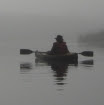Waiting.
The hunters seem to be waiting, waiting for tracking snow. Brian says the only orange hats he has seen are on fellow oilfield workers that don't want to get shot. The flurries we have had over the last few days have finally started to whiten the ground, but I don't know how much is needed for good tracking. When I hunted deer with my sister, we didn't do any tracking; we just walked through the hills until we saw one.
When I pulled into the farmyard yesterday, the ground was crisscrossed with rabbit tracks. They're snowshoe hare, actually, the "bush rabbits" that we see; I believe there may be some cottontails around but they're not common here. The hares have been waiting for snow. A couple of weeks ago, when we first had white everywhere, I noticed one calmly crossing under the six-foot-high catwalk where I was noisily tramping along. He(?) was hardly visible except for the gray rims and black tips on his ears. A few days later, that white fur was shouting for attention, against the brown and grey of the bush and fallen leaves.
In the open country there are jack rabbits (also a type of hare, rather than a true rabbit). I am wondering if the hares around town are jack rabbits, or snowshoe hares. I found the little field guide, "Animal Tracks of Western Canada" by Joanne E. Barwise, that we gave to Ruth about six years ago, and it looks like I should be able to tell by the width of the hind footprints. The dog and I spotted one in Brian's hedge the other day, or actually, hopping out of his hedge when we passed within a few feet of it. Otherwise I don't know if even the dog would have noticed it was there.
This morning as we walked on the trail between the brick ponds and the old railway grade, the dog and I spotted a vole skimming across the trail ahead of us. If it hadn't been for the leash, I think she might have caught it. This is a tough time for the wildlife, not only for the small things that need deeper snow for cover, but also larger animals, since the sloughs and dugouts have frozen over and there isn't yet much snow to eat for water. Plants are getting past the toughest time now, since it is staying cold and not stressing them with freeze-thaw cycles, but a blanket of insulating snow would be welcome for many. All things are waiting.
Back at the farm yesterday, among all the snowshoe hare tracks, there were squirrel tracks too, and a tiny paired row of tracks that probably indicated a shrew. In a remnant of an older drift of snow behind the seed plant, I noticed just a few pairs of weasel prints dimmed by the newer snow, but they are unmistakeable once you know them. On the lane past the barn, right up the middle, was the neat row of cross-shaped prints that testifies to the regal strut of a ruffed grouse.
I saw no deer tracks. In the earlier snowfall, I noticed plenty of deer tracks, and I don't recall that there was much else.
solstice letter
4 weeks ago




2 comments:
Are you waiting for something to put in your freezer, or just to catch a glimpse?
We see hares in the city all the time, but never out here. Odd. I know there're around, but they're awfully wary.
Just to catch a glimpse, this year. I wonder if the wary hares are jack rabbits, and the city hares are snowshoe hares? It strikes me that the jack rabbits are more wary, perhaps because of living in the open all the time.
I remember one time I was walking a pattern over a proposed oil well site, scanning for rare plants. The site was on a high wind-swept bench above a valley, with sparse short grass (well, grass and sedge actually) and not much else. I almost stepped on a young jack rabbit, lying absolutely flat in a very slight hollow, ears down along its neck. Even with me standing there looking at it, it didn't move.
I checked the size of the tracks I see around town, and I'm pretty sure the hares here are jack rabbits.
Post a Comment